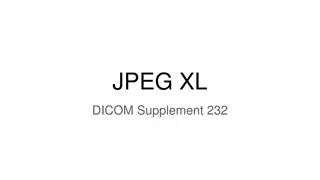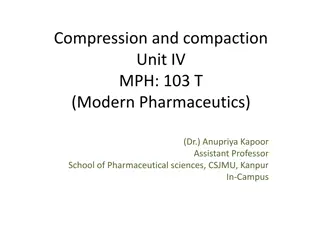Wide-ranging Benefits of Compression Therapy Drive the Market’s Growth
Compression Therapy Market by Product (Bandages, Stockings, Wraps, Socks, Pumps) Technique (Static, Dynamic) Condition (Varicose Vein, Lymphedema, DVT, Leg Ulcer) Distribution Channel (E-commerce, Hospital, Pharmacy & Retailer)
5 views • 2 slides
Modeling and Generation of Realistic Network Activity Using Non-Negative Matrix Factorization
The GHOST project focuses on the challenges of modeling, analyzing, and generating patterns of network activity. By utilizing Non-Negative Matrix Factorization (NMF), realistic network activity patterns can be created and injected into live wireless networks. Understanding and predicting user behavi
4 views • 28 slides
Hot And Cold Compression Therapy | Frozenoasis.com.au
With the hot and cold compression therapy offered by Frozenoasis.com.au, get the maximum amount of relief. Bid farewell to suffering and hello to health. Buy today!\n\n\/\/frozenoasis.com.au\/
3 views • 1 slides
Advantages and Challenges of JPEG XL in Whole Slide Imaging (WSI)
JPEG XL offers significantly smaller images for WSI with lossy compression accepted by regulators, supporting >8-bit compression and safe migration from existing JPEG. However, challenges exist such as lack of universal browser support and potential impact on CAD AI. Mayo's limited testing shows pro
0 views • 6 slides
The Relationship Between Music, Cognition, and Data Compression
Music composition involves creating novel music for specific audiences. When we listen to music, our brain processes sound data through compression, seeking patterns and relationships to understand and appreciate the music better. This cognitive process is crucial for perception, cognition, and crea
0 views • 12 slides
Understanding Multimedia and Digital Video Concepts
Explore the world of multimedia and digital video through this informative content. Learn about the meaning of multimedia, stages of transport in multimedia, key concepts, compression methods, data compression in action, and compression techniques. Discover how multimedia combines text, audio, and i
0 views • 51 slides
Network Compression Techniques: Overview and Practical Issues
Various network compression techniques such as network pruning, knowledge distillation, and parameter quantization are discussed in this content. The importance of pruning redundant weights and neurons in over-parameterized networks is highlighted. Practical issues like weight pruning and neuron pru
0 views • 37 slides
Network Slicing with OAI 5G CN Workshop Overview
Overview of Network Slicing with OAI 5G CN workshop focusing on the crucial role of network slicing in realizing the service-oriented 5G vision. This workshop covers topics like multiple logical networks creation on shared infrastructure, different types of network slices, preparation and instantiat
1 views • 6 slides
Understanding Tablet Compression and Compaction in Modern Pharmaceutics
This educational material delves into the physics of tablet making, focusing on the forces involved, compaction profiles, and effects of friction. Students will gain knowledge about tablet compression, compaction, and consolidation, including the types of forces at play and the distribution of force
0 views • 16 slides
Compression-Driven Point Set Pattern Discovery in Music
Compression-driven point set pattern discovery in music explores the principle of parsimony in data representation. By applying compression-based algorithms, researchers aim to simplify the description of musical data, leading to better performance in tasks such as classification of folk songs, simu
0 views • 12 slides
IEEE 802.11-22/1820r0: Accuracy and Compression of TXBF Feedbacks
This document discusses the accuracy and compression of Transmit Beamforming (TXBF) feedbacks based on Optimal Singular Value Decomposition (SVD). It covers the background, optimal SVD-based TXBF feedback (Decimation), simulation results, and proposals for overhead reduction schemes in the context o
4 views • 17 slides
Excel Tutorial: Evaluating Pay Compression with Compa-Ratios
Learn how to evaluate pay compression using compa-ratios and tenure data in Excel. The tutorial guides you through calculating compa-ratios for customer service representatives, comparing actual pay to the pay range midpoint, and identifying potential pay compression issues.
0 views • 23 slides
Understanding Snort: An Open-Source Network Intrusion Detection System
Snort is an open-source Network Intrusion Detection System (NIDS) developed by Cisco, capable of analyzing network packets to identify suspicious activities. It can function as a packet sniffer, packet logger, or a full-fledged intrusion prevention system. By monitoring and matching network activity
0 views • 23 slides
Addressing Faculty Salary Compression Issues in Higher Education
Faculty salary compression has become a significant challenge in higher education, particularly affecting long-serving faculty members. This issue arises from repeated freezes on the salaries of existing faculty while new hires receive higher market rates. General pay increases and merit processes d
0 views • 6 slides
Introduction to Information Retrieval: Compression Techniques and Index Optimization
Exploring concepts from information retrieval, this content delves into index compression methods such as blocked sort-based indexing and single-pass in-memory indexing. It discusses the importance of compression for inverted indexes to optimize memory usage and decrease disk space requirements, ult
2 views • 50 slides
Introduction to Archiving and Backup Tools in Linux
Learn about essential archiving and backup commands in Linux, including gzip for compression, gunzip for decompression, tar for archiving files, zip for compression and archiving, and unzip for decompressing zip files. Understand the purpose and usage of each command with examples provided.
0 views • 6 slides
Transportation Network Modeling and Analysis with C.Coupled SE Platform
This content outlines the features and functionalities of the C.Coupled SE Platform (CSET Platform) developed by the Connetics Transportation Group. It covers aspects such as interface design, inputs merging, purposes, platform development using Cube, TAZs merging, and network attributes. The platfo
0 views • 11 slides
Introduction to Huffman Coding for Data Compression
Understand the principles of encoding in information systems through topics such as Binary, Morse Code, Prefix Property, Code Optimization, and Huffman Coding. Explore the efficient representation of symbols with varying frequencies using Huffman coding, ensuring a prefix-free code for data compress
0 views • 16 slides
Enhancing I/O Performance Through Adaptive Data Compression in Climate Simulations
This research focuses on improving I/O performance for climate simulations by employing adaptive data compression techniques. Scientific data compression methods, such as lossy and lossless compression, are explored to reduce data volume and increase effective I/O bandwidth. The study highlights the
0 views • 18 slides
Improved Imaging Compression with HTJ2K Transfer Syntax
Challenges with existing compression methods like JPEG 2000 have led to the development of High Throughput JPEG 2000 (HTJ2K), offering faster decoding speeds and support for advanced features like scalable resolution. HTJ2K resolves issues related to complexity, patent conflicts, and lack of open-so
0 views • 6 slides
Understanding Data Storage and Compression Techniques
Explore various concepts related to data storage and compression, including higher revision techniques, watch points for debugging, RAID disk mirroring, media compression methods, mantissa and exponent representation, and the impact of precision/range adjustments in numerical calculations. Learn abo
0 views • 13 slides
Understanding DEFLATE Algorithm: LZ77, Huffman Coding, Compression
DEFLATE algorithm, developed by Kent, combines LZ77 compression with Huffman coding. LZ77 algorithm compresses data using a sliding window technique, while Huffman coding assigns variable-size codewords to characters based on frequency. This process enables efficient data compression and decompressi
0 views • 12 slides
Meridian: An SDN Platform for Cloud Network Services
Meridian is an SDN platform developed by Mohammad Banikazemi, David Olshefski, Anees Shaikh, John Tracey, and GuohuiWang at IBM T. J. Watson Research Center. The platform focuses on providing cloud network services efficiently. It encompasses an architecture that enables faster and more convenient n
0 views • 21 slides
Dictionary Compression and Deep Packet Inspection (DPI) Overview
This content discusses Decompression-Free Inspection (DPI) for shared dictionary compression over HTTP, the challenges and solutions in deep packet inspection (DPI), compressed HTTP methods, examples of intra-response and inter-response compression, and current operations of Network Intrusion Detect
0 views • 33 slides
Multichannel EEG Compression Using COMPROMISE Study
A study on multichannel EEG compression using COMPROMISE by Duc Thien Pham, Josef Kohout, Ivana Kolingerova, Pavel Nejdar from the Department of Computer Science and Engineering, Faculty of Applied Sciences, University of West Bohemia. The study covers datasets, methods, and discussions related to E
0 views • 12 slides
Understanding the Burrows-Wheeler Transform and Suffix Array
Explore the concept of the Burrows-Wheeler Transform and Suffix Array, key algorithms in data compression. Learn about the transformation process, suffix arrays, compression techniques like Bzip, and how to compute the BWT. Discover the significant role these methods play in efficient data compressi
0 views • 10 slides
Comprehensive Overview of Multi-delimiter Data Compression Codes and Key Features
This content showcases the concept of multi-delimiter data compression codes, their application in various algorithms such as arithmetic, finite state entropy, Huffman, and Fibonacci. Key features including compression rate, synchronization, search in compressed files, encoding/decoding speed, and c
0 views • 27 slides
Understanding Normal Shock Waves in Gas Dynamics
In gas dynamics, normal shock waves occur when there is a significant pressure difference across a compression pulse, leading to increased entropy. This results in non-isentropic flow known as compression shock waves. The formation of compression and expansion waves can be likened to piston movement
0 views • 16 slides
Understanding Network Analysis: Whole Networks vs. Ego Networks
Explore the differences between Whole Networks and Ego Networks in social network analysis. Whole Networks provide comprehensive information about all nodes and links, enabling the computation of network-level statistics. On the other hand, Ego Networks focus on a sample of nodes, limiting the abili
0 views • 31 slides
Lossless Compression Techniques in Digital Image Analysis
Explore various coding techniques used for lossless compression in digital image analysis, including RLE, Huffman coding, arithmetic coding, LZW, and DPCM. Learn about run-length encoding, 2D RLE, and how DPCM encodes changes between consecutive samples to achieve compression while preserving image
0 views • 39 slides
Understanding Image Compression Techniques
Image compression is essential for reducing file sizes without significant loss of quality. This article explores three common techniques: Run-Length Encoding, Arithmetic Encoding, and their applications in data compression. Learn about encoding intervals, probability ranges, and decoding processes
0 views • 33 slides
Revolutionizing Image Compression with HTJ2K Transfer Syntax
Revolutionize image compression with HTJ2K Transfer Syntax, a groundbreaking technology that addresses existing challenges in compression standards like JPEG 2000. HTJ2K offers improved decode and encode speeds, strong open-source support, and scalable resolution access. Explore how HTJ2K is reshapi
0 views • 6 slides
Understanding Tablet Compression Machine Process
The process of tablet compression involves filling, compression, and ejection of granules to create tablets. Different types of tablet machines, such as single punch and multi-station rotary presses, are used in the process. Components like hoppers, dies, punches, cam tracks, and feeding mechanisms
0 views • 8 slides
Network Function Virtualization (NFV) Overview
Network Function Virtualization (NFV) focuses on virtualizing network functions to improve efficiency and reduce costs in network infrastructure. The lecture discusses key readings, devices that compose a network, specialization of devices, benefits of one-device-does-anything approach, and the goal
0 views • 21 slides
Enhancing Network Stability with Network Monitoring Systems
Network monitoring is crucial for efficient management and proactive issue detection in a network environment. Factors influencing an effective network system include choosing the best OEM, SLA agreements, and selecting a reliable System Integrator. Reactive monitoring can lead to financial losses a
0 views • 12 slides
Efficient Image Compression Model to Defend Adversarial Examples
ComDefend presents an innovative approach in the field of computer vision with its efficient image compression model aimed at defending against adversarial examples. By employing an end-to-end image compression model, ComDefend extracts and downscales features to enhance the robustness of neural net
0 views • 16 slides
Enhancing Memory Bandwidth with Transparent Memory Compression
This research focuses on enabling transparent memory compression for commodity memory systems to address the growing demand for memory bandwidth. By implementing hardware compression without relying on operating system support, the goal is to optimize memory capacity and bandwidth efficiently. The a
0 views • 34 slides
Overview of MPEG: Video Compression Standard
The MPEG video compression standard revolutionized multimedia applications by enabling full-motion video over networks. Introduced in 1988 by the Motion Picture Experts Group, MPEG-1 focused on video compression but also included audio, with notable advancements like MP3. This standard addressed the
0 views • 29 slides
Accelerating Systemic Change Network Inaugural Workshop Summary
The Accelerating Systemic Change Network held its inaugural workshop at Howard Hughes Medical Institute in July 2016 to address the lack of coordination in improving higher education. With a vision to become a professional hub for change researchers in STEM education, the network aims to enhance ind
0 views • 5 slides
University Network Section Overview July 2015 - March 2016
The presentation covers the network team structure, team members, objectives, goals, report outline, network statistics, accomplishments, and future plans of the university network section from July 2015 to March 2016. It highlights efforts to provide stable internet and intranet services, restructu
0 views • 16 slides







































